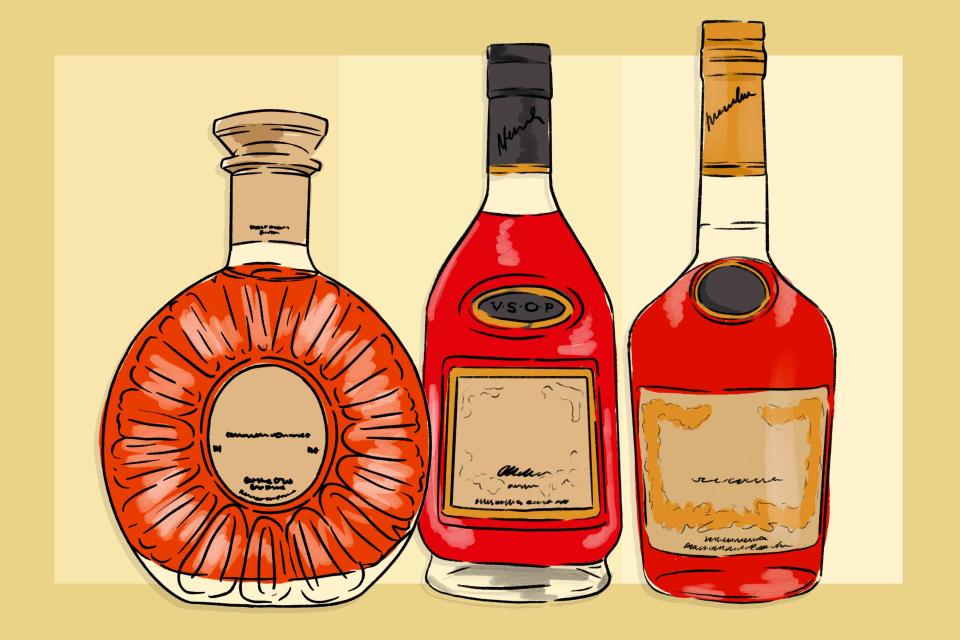What’s the Difference Between VS, VSOP, and XO Cognac?
Is XO Cognac better than the other categories?

Sarah Maiden / Food & Wine
For anyone who has ever seen a bottle of Cognac with its VS, VSOP, or XO labels and wondered exactly what it all means, you are not alone. This cryptic, all-caps labeling can be confusing. At their most simple, they indicate how old the Cognac in that bottle is. But let’s be real, nothing is ever that simple.
Cognac carries a certain upmarket cachet, thanks to its undeniable French-ness, and with it a whole set of terminology. Labeling can inform a lot about what’s in the bottle and can refer not only to the age of the liquid but also to the area in which the grapes are grown and the type of woods used to age it. To better understand what VS, VSOP, or XO means, it’s helpful to know about the spirit itself.
What is Cognac?
Cognac is a type of brandy produced in the area surrounding the French commune of Cognac, located in the departments of Charente and Charente-Maritime, just north of Bordeaux. It’s made most often from Ugni Blanc grapes from Saint-Émilion, though certain other varieties can also be used, and aged for at least two years in French oak barrels from forests in Limousin or Tronçais.
What do VS, VSOP, and XO mean?
The Bureau National Interprofessionnel du Cognac (BNIC) is the “decision-making body for the cognac industry,” and is responsible for all labeling rules.
VS (Very Special) is a blend of cognacs with the youngest eau-de-vie aged for at least two years.
VSOP (Very Superior Old Pale) contains eau-de-vie that is at least four years old.
XO (Extra Old) are cognacs that, as of 2018, must be aged for at least 10 years.
"“VS, VSOP or XO categories determine the aging only, it is not telling you anything about the quality, but only the aging." — Cognac Park master blender Jérôme Tessendier"
Eau-de-vie is young brandy that will become Cognac once it reaches the statutory age, and since Cognac is a blended spirit, brandies of various ages go into the making of every bottling. The designations only comment on the youngest eau-de-vie used to make those bottles. Meaning a VS Cognac could be made from one percent two-year-old Cognac and 99 percent 20-year-old cognac and it would still be labeled VS. And while the above example is a clear exaggeration, cognac makers often blend much older Cognacs into younger labeled bottlings to give them the flavor and depth they’re looking for.
“VS, VSOP or XO categories determine the aging only, it is not telling you anything about the quality, but only the aging,” says Cognac Park master blender Jérôme Tessendier. Adding, “It's a different job to produce a young cognac and an old cognac.”
VS (Very Special)
For VS cognacs, you “usually put your spirit in new oak,” says Tessendier. This is so the young spirit extracts the tannin, which is important during the short aging process. “It's very precise work,” he says, explaining that it’s a challenge with “such a short amount of time in new oak to be sure that after two, four, five years, [that] you have a good expression, and no bitterness from the oak.”
Tessendier moves his eau-de-vie into new barrels every six to nine months, looking to extract the tannins, before moving it to mature casks. Tessendier says the base of their VS is around four to five years old, but can also integrate even older cognacs.
According to both Cognac Park and Martell, VS Cognacs are best enjoyed in cocktails or in long drinks.
VSOP (Very Special Old Pale)
“VSOP is in the middle,” says Tessendier. Despite its minimum of four years, VSOP is generally aged for much longer. For example, the eau-de-vie that goes into Remy Martin’s VSOP is between four and 12 years old. At Cognac Park, they generally don’t use anything that’s less than five years old. “We consider that between four and five, something happens in the maturation,” says Tessendier. “Four years old we consider too young. From five, you’ve got different kinds of flavors,” he says.
The versatility of VSOP makes it so you can enjoy it in a variety of ways: Neat, on ice, or in long drinks, and cocktails. Rémy Martin’s cellar master Baptiste Loiseau enjoys his with ginger ale.
XO (Extra Old)
XO means that the eau-de-vie has been aged for at least 10 years, but that wasn’t the case just a few years ago. Until 2018, the youngest eau-de-vie only had to be aged for six years to be called XO (which also sometimes goes by the name “Napoleon” and also includes the category Hors d'Age, which means “beyond age.”)
For XO Cognacs, the eau-de-vie is often left in new barrels longer, from “12 months to two years,” says Tessendier. The longer aging time allows for more oxidation and maturation, and for the Cognac to soften.
The term Hors d'Age, meanwhile, tends to describe the oldest and most expensive cognacs. While officially it’s the same class as the XO age denomination, it’s used for Cognacs that have an average age of 30 years or older — it can even reach beyond 100.
XO Cognac isn’t usually mixed with anything. You generally enjoy it neat, on ice, or with a splash of water.
For more Food & Wine news, make sure to sign up for our newsletter!
Read the original article on Food & Wine.

 Yahoo Movies
Yahoo Movies 
